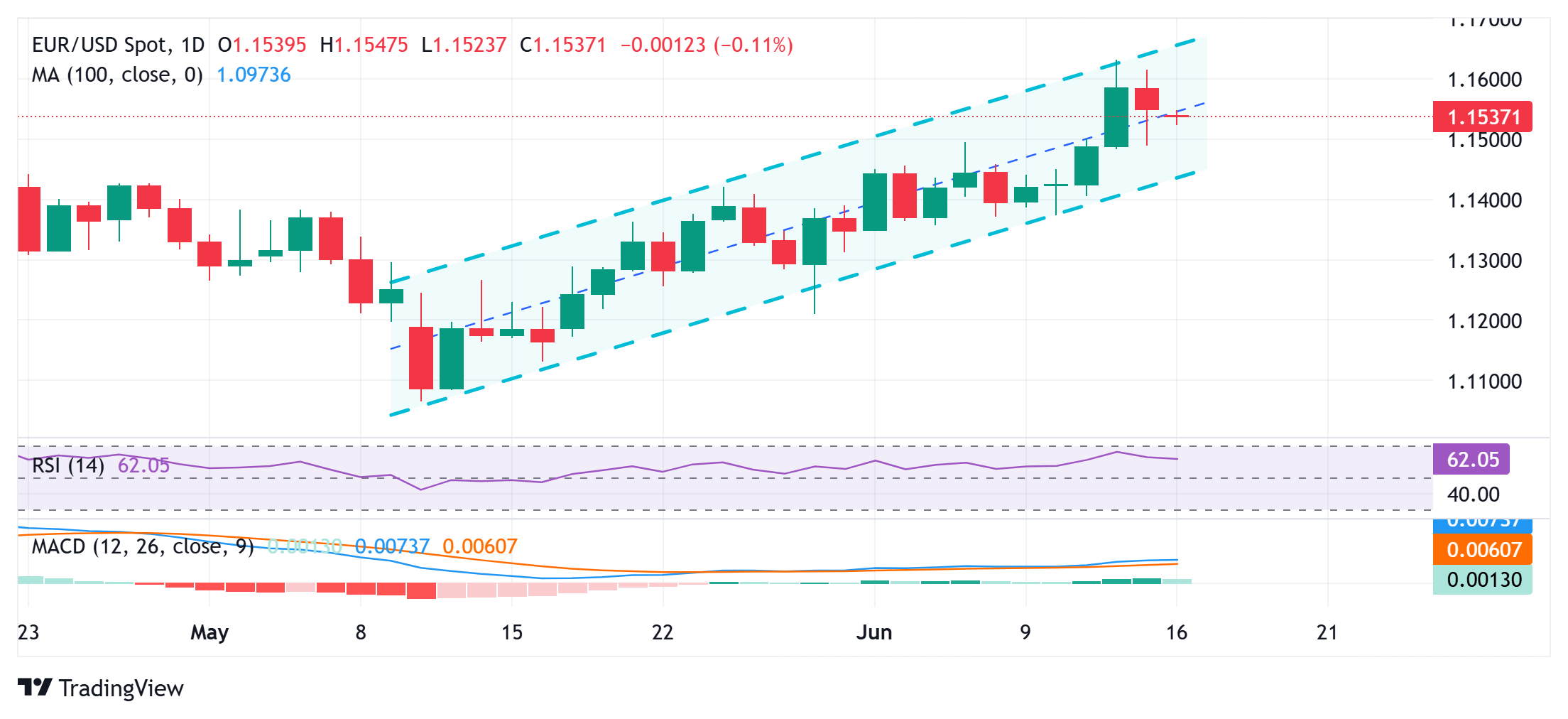Created
: 2025.06.16














![]() 2025.06.16 14:05
2025.06.16 14:05
The EUR/USD pair trades with a mild negative bias below mid-1.1500s through the Asian session on Monday amid a modest US Dollar (USD) uptick, though it lacks bearish conviction. Spot prices remain close to the highest level since October 2021, around the 1.1630 area touched last week as traders now look to the crucial FOMC policy decision on Wednesday before placing fresh directional bets.
Heading into the key central bank event risk, expectations that the Federal Reserve (Fed) will resume its rate-cutting cycle in September might hold back the USD bulls from placing aggressive bets. Moreover, the European Central Bank's (ECB) hawkish signal, that the end of the rate-cutting cycle is nearing, should act as a tailwind for the shared currency and continue supporting the EUR/USD pair.
From a technical perspective, the recent move-up witnessed over the past month or so, along an ascending channel, points to a well-established short-term uptrend and favors bullish traders. Moreover, oscillators on the daily chart are holding in positive territory and suggest that the path of the least hurdle for the EUR/USD pair is to the upside. Hence, any corrective slide could be seen as a buying opportunity.
In the meantime, the 1.1500 psychological mark could protect the immediate downside ahead of the 1.1450-1.1445 horizontal resistance breakpoint. This is closely followed by the trend-channel support, around the 1.1435-1.1430 area, which should act as a pivotal point. A convincing break below the latter could drag the EUR/USD pair further below the 1.1400 mark, towards the 1.1370-1.1365 support zone.
On the flip side, the 1.1570 area, followed by the 1.1600 round figure and the 1.1630 region, or the multi-year peak touched last Thursday, now seems to act as immediate hurdles. Some follow-through buying beyond the 1.1655-1.1660 zone, or the top end of the short-term ascending channel, will be seen as a fresh trigger for bullish traders and allow the EUR/USD pair to aim towards conquering the 1.1700 mark.

The Euro is the currency for the 19 European Union countries that belong to the Eurozone. It is the second most heavily traded currency in the world behind the US Dollar. In 2022, it accounted for 31% of all foreign exchange transactions, with an average daily turnover of over $2.2 trillion a day. EUR/USD is the most heavily traded currency pair in the world, accounting for an estimated 30% off all transactions, followed by EUR/JPY (4%), EUR/GBP (3%) and EUR/AUD (2%).
The European Central Bank (ECB) in Frankfurt, Germany, is the reserve bank for the Eurozone. The ECB sets interest rates and manages monetary policy. The ECB's primary mandate is to maintain price stability, which means either controlling inflation or stimulating growth. Its primary tool is the raising or lowering of interest rates. Relatively high interest rates - or the expectation of higher rates - will usually benefit the Euro and vice versa. The ECB Governing Council makes monetary policy decisions at meetings held eight times a year. Decisions are made by heads of the Eurozone national banks and six permanent members, including the President of the ECB, Christine Lagarde.
Eurozone inflation data, measured by the Harmonized Index of Consumer Prices (HICP), is an important econometric for the Euro. If inflation rises more than expected, especially if above the ECB's 2% target, it obliges the ECB to raise interest rates to bring it back under control. Relatively high interest rates compared to its counterparts will usually benefit the Euro, as it makes the region more attractive as a place for global investors to park their money.
Data releases gauge the health of the economy and can impact on the Euro. Indicators such as GDP, Manufacturing and Services PMIs, employment, and consumer sentiment surveys can all influence the direction of the single currency. A strong economy is good for the Euro. Not only does it attract more foreign investment but it may encourage the ECB to put up interest rates, which will directly strengthen the Euro. Otherwise, if economic data is weak, the Euro is likely to fall. Economic data for the four largest economies in the euro area (Germany, France, Italy and Spain) are especially significant, as they account for 75% of the Eurozone's economy.
Another significant data release for the Euro is the Trade Balance. This indicator measures the difference between what a country earns from its exports and what it spends on imports over a given period. If a country produces highly sought after exports then its currency will gain in value purely from the extra demand created from foreign buyers seeking to purchase these goods. Therefore, a positive net Trade Balance strengthens a currency and vice versa for a negative balance.
![]()
Created
: 2025.06.16
![]()
Last updated
: 2025.06.16

FXStreet is a forex information website, delivering market analysis and news articles 24/7.
It features a number of articles contributed by well-known analysts, in addition to the ones by its editorial team.
Founded in 2000 by Francesc Riverola, a Spanish economist, it has grown to become a world-renowned information website.
We hope you find this article useful. Any comments or suggestions will be greatly appreciated.
We are also looking for writers with extensive experience in forex and crypto to join us.
please contact us at [email protected].
Disclaimer:
All information and content provided on this website is provided for informational purposes only and is not intended to solicit any investment. Although all efforts are made in order to ensure that the information is correct, no guarantee is provided for the accuracy of any content on this website. Any decision made shall be the responsibility of the investor and Myforex does not take any responsibility whatsoever regarding the use of any information provided herein.
The content provided on this website belongs to Myforex and, where stated, the relevant licensors. All rights are reserved by Myforex and the relevant licensors, and no content of this website, whether in full or in part, shall be copied or displayed elsewhere without the explicit written permission of the relevant copyright holder. If you wish to use any part of the content provided on this website, please ensure that you contact Myforex.
Myforex uses cookies to improve the convenience and functionality of this website. This website may include cookies not only by us but also by third parties (advertisers, log analysts, etc.) for the purpose of tracking the activities of users. Cookie policy